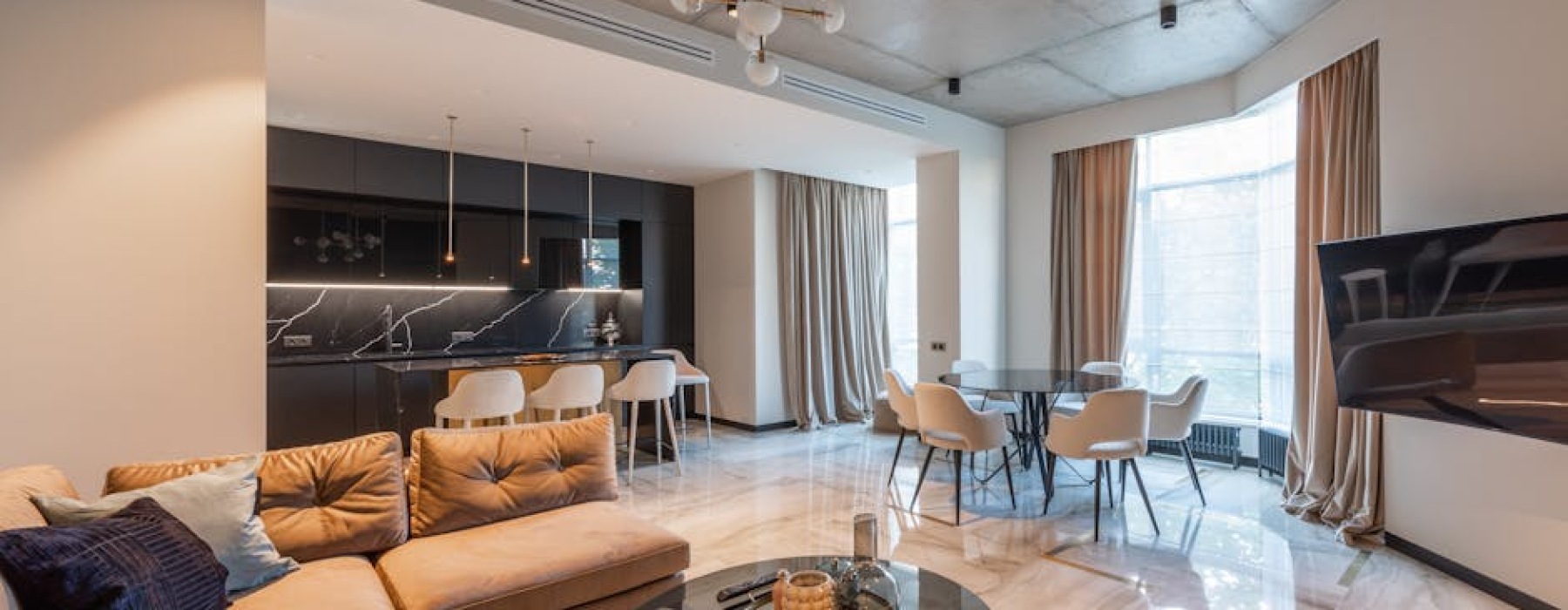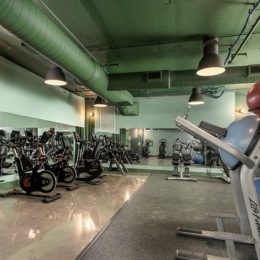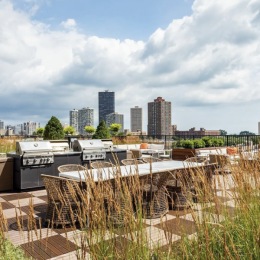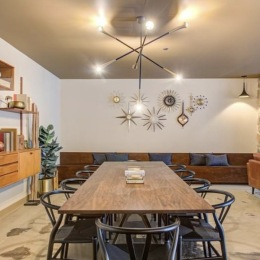Understanding Open Floor Plan Apartments in Modern Living
Open floor plan apartments combine the kitchen, living room, and dining areas into one large, continuous space with minimal interior walls. This popular design trend creates a sense of spaciousness and improves social flow, making it ideal for entertaining and modern urban living.
Key Features of Open Floor Plan Apartments:
- Kitchen Integration: Kitchen opens directly into living and dining areas
- Minimal Walls: Few or no interior walls separating main living spaces
- Improved Flow: Easy movement between cooking, dining, and relaxing areas
- Natural Light: Light travels freely throughout the entire space
- Social Connection: Perfect for entertaining and family interaction
The open concept trend started gaining popularity in the 1990s, inspired by converted artist lofts in New York City's SoHo neighborhood. What began as a practical solution for artists needing large studio spaces has evolved into one of the most sought-after features in modern apartment living.
Today's open floor plans reflect how we actually live - cooking while chatting with guests, watching TV while preparing meals, and creating flexible spaces that adapt to our daily routines. As one real estate professional noted, "People don't use the traditional dining room anymore. Most of those rooms are being combined and converted into open kitchens, making a great suburban space."
This shift makes perfect sense for urban professionals who value both style and functionality in their living spaces. Open layouts maximize the feeling of space in city apartments while supporting the social, connected lifestyle that many renters desire.
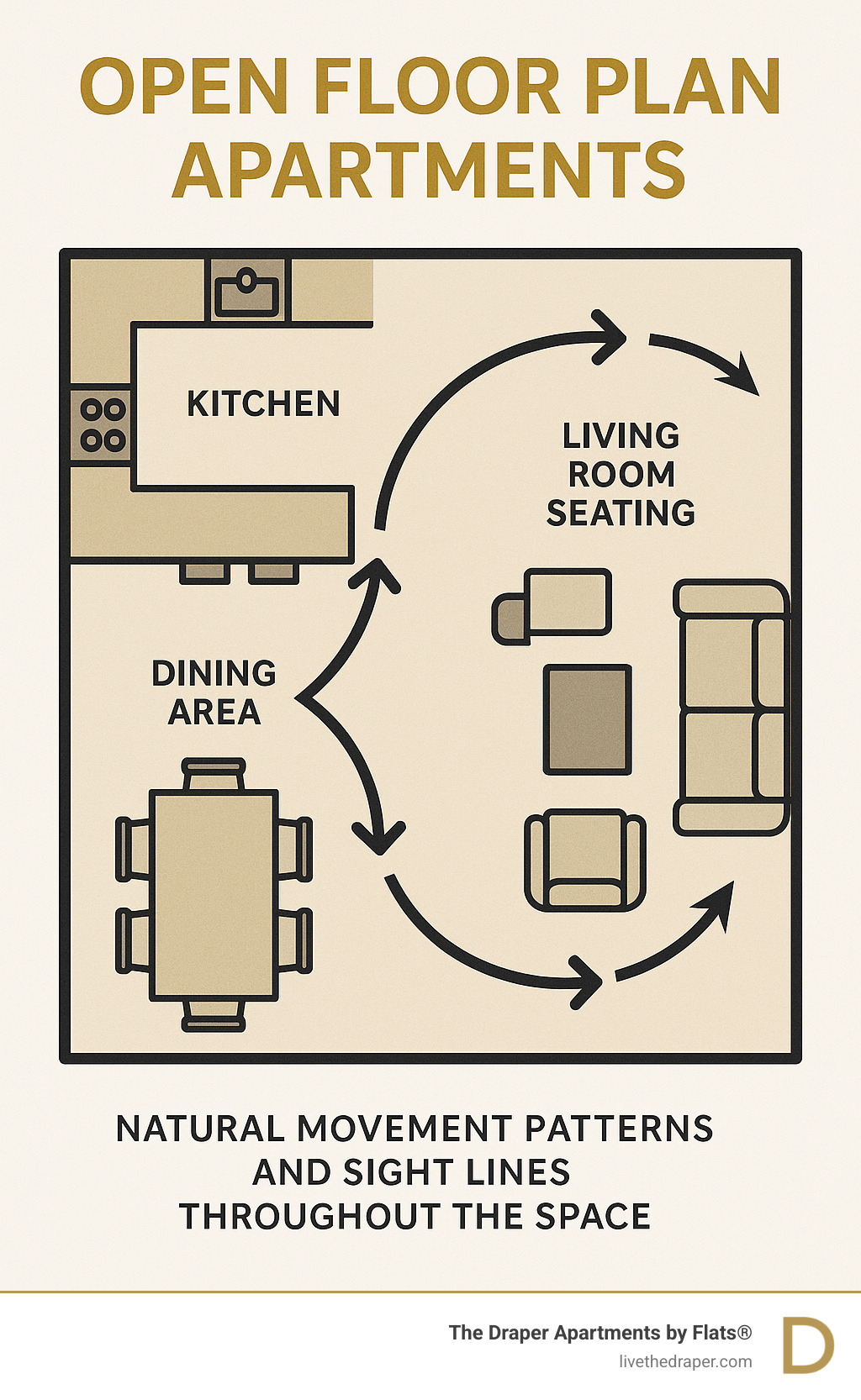
The Evolution of Open Concept Living
The idea of open living spaces isn't new, but its widespread adoption in residential architecture is a recent phenomenon. To understand open floor plan apartments, it helps to look at their journey from niche to mainstream.
Historically, homes featured distinct, separate rooms for specific functions, with walls providing structural support, privacy, and heat containment.
Historical Origins
The genesis of modern open concept living traces back to the artistic communities of the 19th and 20th centuries. In cities like Paris and later New York's SoHo, artists converted industrial lofts into combined living and working studios. They acceptd the vast, flexible interiors with soaring ceilings and expansive windows, making a lifestyle statement that embodied a bohemian spirit.
During this time, architects like Frank Lloyd Wright also challenged traditional design. His "organic architecture" aimed to break down rigid, box-like structures, creating more fluid, interconnected spaces. His ideas laid crucial groundwork for moving away from compartmentalized living.
Architectural Shifts and Engineering Advancements
The adoption of open floor plans was propelled by engineering advances. In older buildings, numerous load-bearing walls were critical for structural integrity. Modern techniques, like steel beams and reinforced concrete, allowed architects to design buildings with fewer internal supports. This breakthrough freed up floor plans, making it possible to create vast, uninterrupted spaces.
From Niche to Mainstream
The "cool" factor of loft living captured the public's imagination in the 1990s. Developers began building new condos and apartments that mimicked the loft aesthetic, offering the open feel with modern amenities. These "soft lofts" made open concept living accessible to a wider market.
The shift was also driven by evolving lifestyles. As lives became less formal, traditional dining rooms saw less use. People wanted to connect more, whether it was parents cooking while watching children or hosts engaging with guests. As one industry insider noted, "People don't use the traditional dining room anymore. Most of those rooms are being combined and converted into open kitchens... a room that is used every day."
This desire for increased flow, natural light, and connectedness transformed living spaces. Open floor plans became a modern must-have, maximizing the feeling of openness, even in smaller units. The trend is here to stay, as open layouts "maximize space... and they increase flow. They just make so much more sense."
This evolution reflects a deeper understanding of how modern individuals and families want to live. For more design inspiration and how open concepts are being accepted globally, you can explore More design inspiration from Dwell. To dig deeper into the core meaning of this popular design, check out What Does “Open Concept” Really Mean?.
The Pros and Cons of Open Floor Plan Apartments
When considering open floor plan apartments, it's important to weigh whether this popular design fits your lifestyle. Open concepts come with a unique blend of benefits and challenges affecting how you socialize, function, and feel in your space. Understanding both sides helps you make an informed choice.
The Advantages of an Open Layout
Open floor plan apartments have become a gold standard in modern living for several key reasons that genuinely improve daily life.

- Improved Social Flow: When hosting, you're part of the conversation instead of being isolated in the kitchen. Conversations flow naturally from cooking to dining to lounging, making the kitchen the heart of social gatherings.
- Maximized Sense of Space: With fewer walls, the eye travels across the entire area, creating an illusion of more square footage. This is especially valuable in urban apartments.
- Increased Natural Light: Sunlight can reach every corner of the main living area, creating brighter mornings and an airy atmosphere that makes any space more welcoming.
- Easier Supervision of Children: Parents can keep an eye on kids playing in the living area while preparing meals, providing peace of mind.
- Multifunctional Flexibility: Spaces adapt to your needs. A dining area can double as a home office, or a living room can become a workout space by simply moving a coffee table.
- Creative Furniture Arrangement: Without walls dictating placement, you can experiment with different configurations to suit your lifestyle.
These advantages explain the appeal of open living. You can explore how these benefits come together in thoughtfully designed spaces at Apartments with Open Floor Plans.
Potential Drawbacks and How to Solve Them
While beneficial, open layouts have challenges. The good news is that most have practical solutions.
- Lack of Privacy: Create visual and physical boundaries with decorative screens, tall bookshelves, or large plants to form intimate nooks.
- Noise Travel: Combat amplified sounds from the kitchen or TV with soft, sound-absorbing furnishings like plush area rugs, heavy curtains, and upholstered furniture.
- Cooking Odors and Mess: A powerful range hood is essential. Modern apartments often include excellent ventilation. Keep attractive storage handy for quick cleanup.
- Visual Clutter: With everything on display, smart storage is key. Use built-in cabinets, decorative baskets, and furniture with hidden storage to maintain a clean look.
- Temperature Regulation: Maintaining a consistent temperature in a large, open area can be a challenge. Modern buildings often address this with energy-efficient HVAC systems, quality insulation, and smart thermostats to ensure comfort throughout the space.
Most challenges of open living are solved with thoughtful design and good habits. Well-designed apartments with modern amenities often have these solutions built-in.
Designing and Defining Your Open Space
The beauty of open floor plan apartments lies in their flexibility, but this same openness can sometimes feel overwhelming. How do you create the cozy feeling of separate rooms when there are no walls to define them? The secret is learning to work with invisible boundaries.
Think of your open space like a blank canvas. You're not painting walls back in – you're creating visual cues that naturally guide the eye and body through different areas. Interior design strategies become your best friend here, helping you craft distinct zones that each serve their own purpose while maintaining that gorgeous, flowing connection.
The goal isn't to recreate the rigid separation of traditional apartments. Instead, you're creating gentle suggestions – a dining area that feels intimate for morning coffee, a living space perfect for movie nights, and a kitchen zone that welcomes conversation while you cook.
Strategies for Creating Distinct Zones
Creating zones in an open space is like choreographing a dance. Each area needs its own identity while moving gracefully with the others. The trick is using furniture, lighting, and design elements as your invisible room dividers.

Area rugs work like magic to anchor different spaces. A plush rug under your dining table instantly creates a "dining room," while another rug defines your seating area. Choose rugs that complement each other but don't match exactly – this adds visual interest while maintaining harmony.
Furniture becomes your room divider without blocking light or conversation. The back of a sectional sofa naturally separates your living area from the dining space. A console table behind your couch can hold lamps and decorative items while creating that gentle boundary you need.
Strategic furniture grouping transforms your open space into intimate conversation areas. Instead of pushing everything against the walls, pull pieces toward the center. Create a cozy seating arrangement where chairs and sofas face each other, making the space feel more like a traditional living room.
Lighting fixtures are incredibly powerful zone creators. A statement pendant light over your dining table clearly defines that area, while floor lamps create pools of warm light that make your reading nook feel special. Different lighting for different areas also lets you set various moods throughout your space.
Accent walls can anchor specific zones without closing them off. A bold paint color or interesting wallpaper behind your dining area creates a focal point that defines the space while keeping everything open and flowing.
Bookshelves work as transparent dividers, offering storage and display space while maintaining that open feel. Choose open-backed shelving that lets light pass through but still creates a sense of separation between your work area and living space.
These techniques work beautifully in spacious layouts like those found in our Luxury Two Bedroom Apartments Uptown Chicago. The key is experimenting until you find the combination that feels right for your lifestyle. And remember, our Chicago Apartments with Amenities offer common areas that extend your living space, giving you even more room to spread out when you need it.
Open Concept vs. Traditional Layouts
Understanding how open floor plan apartments compare to traditional layouts helps you appreciate what makes each special. Both have their place in modern living, and your choice often comes down to how you actually live your daily life.
| Feature | Open Concept Floor Plan | Traditional, Room-Divided Floor Plan |
|---|---|---|
| Social Flow | Excellent; promotes interaction and connectivity | Limited; can isolate people in separate rooms |
| Privacy | Lower in main living areas; requires creative zoning | Higher; distinct rooms offer more seclusion |
| Natural Light | Maximized; light penetrates deeper into the space | Can be limited by walls; some rooms may be darker |
| Noise Containment | Lower; sound travels easily throughout the entire space | Higher; walls and doors help contain noise |
| Sense of Space | Feels larger, more expansive, and airy | Can feel smaller or more compartmentalized |
| Flexibility | High; easily adaptable for different activities and layouts | Lower; rooms have fixed purposes and boundaries |
Traditional floor plans offer the comfort of clearly defined spaces. Each room has its purpose – the dining room for special dinners, the living room for relaxing, the kitchen for cooking. This works wonderfully if you prefer distinct boundaries and enjoy the ritual of moving from space to space for different activities.
The traditional approach often features split-bedroom layouts where bedrooms are grouped together, creating clear separation between public and private areas. Hallways and doors provide natural sound barriers, making it easier to have quiet conversations or watch TV without disturbing others.
But modern living has shifted toward connection and flexibility. We cook while chatting with family, work from our dining tables, and want guests to feel welcome in every part of our homes. Open concepts support this lifestyle beautifully, making even smaller spaces feel grand and welcoming.
Some luxury apartments now offer the best of both worlds with features like oversized pocket doors that can open walls between rooms. This gives you the option to create an expansive entertaining space or close off areas when you need privacy or quiet.
At The Draper, we design our spaces to support how people actually live today. Whether you choose a cozy studio or a spacious two-bedroom, you'll find thoughtful layouts that feel like home from day one.
Open Concepts in Modern Architecture
The accept of open concepts extends far beyond apartment living – it represents a fundamental shift in how we think about architectural design. Today's architects and developers recognize that open floor plan apartments aren't just trendy; they reflect how people actually want to live.
This architectural philosophy has found its way into various property types and design styles, each bringing its own interpretation of spacious, connected living. From converted industrial buildings to brand-new luxury developments, the open concept has proven its versatility and staying power.
Understanding Loft Apartments: Hard vs. Soft Lofts
When most people picture open floor plan apartments, loft living immediately comes to mind. There's something undeniably appealing about these expansive spaces with their soaring ceilings and wall-to-wall windows that flood every corner with natural light.
A true loft apartment is defined by its generous open space with minimal interior walls. These units typically feature high ceilings of 10 feet or more and large windows that create an airy, light-filled atmosphere. What many people don't realize is that lofts tend to be significantly larger than typical studios – often ranging from 1,000 to 2,000 square feet compared to a studio's average of 600 square feet.
But not all lofts tell the same story. Understanding the difference between hard lofts and soft lofts helps explain the evolution of open concept living.
Hard lofts are the originals – authentic conversions of industrial or commercial buildings like warehouses, factories, or old school buildings. These spaces carry their history in every detail: exposed brick walls, visible ductwork, concrete floors, and large support columns that once held up heavy machinery. The raw, unfinished ceilings and industrial fixtures aren't design choices; they're remnants of the building's working past.
These spaces originated from artists who needed large studios for their work. The "cool factor" associated with hard lofts comes from this creative heritage and the bohemian lifestyle they represent. At The Draper, we honor this spirit by blending modern finishes with historic charm, incorporating features like brick walls and high ceilings that echo these original artistic spaces.
Soft lofts emerged as developers recognized the high demand for loft-style living. These are new constructions designed to capture the aesthetic appeal of hard lofts while offering modern conveniences. They feature the signature open floor plans, high ceilings, and large windows, but with contemporary building standards, updated mechanical systems, and modern Amenities.
Soft lofts give you the spacious, open feel without some of the quirks that can come with older converted buildings – things like drafts, limited storage, or outdated electrical systems. They're designed to replicate the industrial aesthetic while providing the comfort and functionality today's residents expect.
Whether hard or soft, lofts offer the quintessential open concept experience with their vast, flexible living areas. We offer thoughtfully designed layouts from spacious studios to two-bedroom options, many embodying these open living principles. For those drawn to the flexibility of smaller open layouts, explore our Luxury Studio Apartments Chicago.
Architectural Styles That Accept Openness
The open concept isn't limited to loft living – it's become a cornerstone of several popular architectural styles, each bringing its own flavor to spacious design.
Modern architecture wholeheartedly accepts open floor plans with its emphasis on clean lines, minimalism, and functionality. The goal is creating uncluttered, light-filled spaces that promote flow and connection. There's no room for unnecessary walls when the focus is on essential elements and purposeful design.
Contemporary design takes a similar approach but remains more fluid and adaptable to current trends. It's about creating spaces that reflect how people live today – multitasking, entertaining, and moving freely between activities throughout their day.
Industrial style draws directly from hard loft aesthetics, celebrating raw materials and exposed structural elements. Open floor plans are essential to this style, showcasing the vastness and utilitarian beauty that made these former factory spaces so appealing to artists decades ago.
Scandinavian design naturally aligns with open concepts through its emphasis on light, simplicity, and functionality. These layouts maximize natural light and create airy, uncluttered environments that feel serene and spacious – perfect for the long, dark winters that inspired this design philosophy.
Minimalist principles thrive in open spaces where less truly becomes more. The lack of interior walls prevents visual clutter and allows for the streamlined aesthetic that minimalism celebrates. Every element has purpose, and nothing competes for attention.
These architectural styles demonstrate that open concepts aren't just a passing trend – they're a deeply integrated element of how we approach contemporary living. Our apartments in Uptown Chicago embody these principles, offering layouts that are both stylish and highly functional for modern residents.
The beauty of open concept design lies in its adaptability. Whether you're drawn to the raw authenticity of industrial style or the serene simplicity of Scandinavian design, open floor plan apartments provide the perfect canvas for expressing your personal aesthetic. Explore how these concepts come to life in our Chicago Uptown Apartments for Rent and find the architectural style that speaks to you.
Conclusion
This exploration of open floor plan apartments has uncovered a fascinating story, from bohemian artist studios to today's most coveted living spaces. These layouts have transformed the idea of home, breaking down the rigid walls that once separated daily activities.
The journey from 19th-century ateliers to modern Chicago apartments shows that open concepts are not just a passing trend—they are a response to how people want to live. These spaces excel at bringing people together, whether for hosting friends or chatting with family while cooking. The way natural light flows freely, making even smaller spaces feel expansive and welcoming, continues to capture hearts and minds.
The challenges, such as privacy concerns, cooking odors, and noise travel, are real considerations. However, with thoughtful design solutions—from strategic furniture placement to powerful ventilation systems—these problems become manageable. The key is understanding that open living requires a slightly different approach that accepts flexibility and creativity.
What is most striking is how these layouts reflect modern values: connection over separation, flexibility over rigidity, and spaces that adapt to ever-changing needs. Whether it's a converted hard loft with exposed brick or a thoughtfully designed soft loft with contemporary finishes, open concepts provide room to breathe and grow.
At The Draper Apartments, it's clear how the right open layout can transform daily life. Residents love how these spaces encourage spontaneous conversations and effortless entertaining. The way the apartments blend the openness of loft-style living with modern conveniences creates homes that work for contemporary lifestyles.
Open floor plan apartments represent more than a design choice—they're about creating spaces where life unfolds naturally. From cooking breakfast while catching up on the news to seamlessly transitioning from work-from-home mode to relaxation, these layouts support the fluid way we live today.
Find how these thoughtfully designed spaces can improve your own lifestyle. Explore the vibrant Uptown Chicago neighborhood and experience how open concept living can create the perfect backdrop for your modern life.

